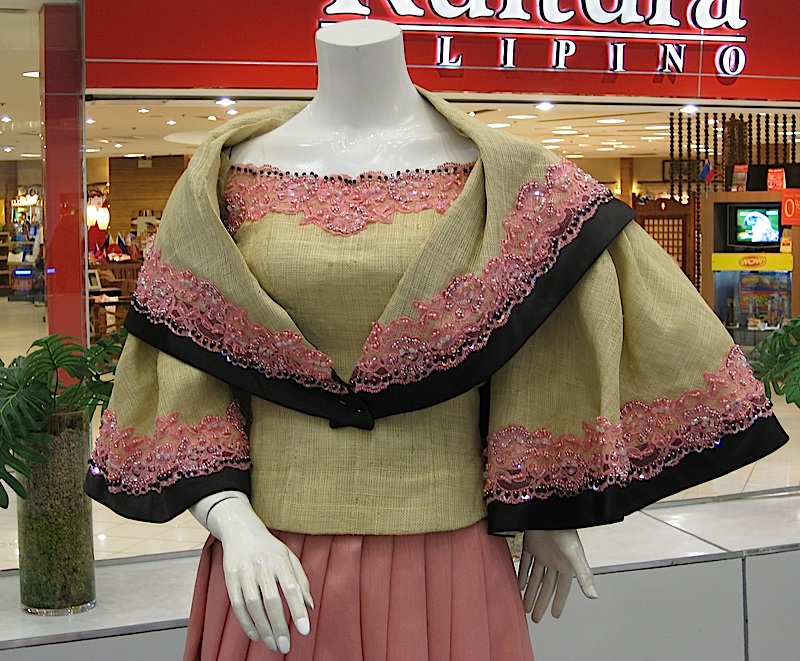
August 31, 2009
Manila hemp
During Spanish colonial times, one of the most important export products of the Philippines was marine rope made out of abaca (Musa textilis) fiber, known worldwide then and now as Manila hemp. It proved to be more flexible and resistant to salt water damage than rope made out of hemp, to which it has no relation whatsoever. Classified as a hard fiber, abaca is one of the strongest and most durable natural fibers in the world. Its pulp is used to make specialty papers for tea bags and money. It is also used widely in Philippine handicrafts like furniture, rugs and carpets, clothing and fashion accessories. This Filipiniana dress designed by Jontie Martinez, part of the Maria Clara exhibit I caught at The Block at SM City North EDSA, features a kimona (the blouse) and panuelo (the shawl) made out of abaca. With today's technology, textiles using the fiber can be as delicate and smooth as silk but it was the rough texture of this piece—its 'naturalness,' if you will—that caught my eye. Amazingly and wonderfully, the coarse-looking cloth proved to be very soft and smooth to the touch.


August 30, 2009
Waiting to leave
Back in November, I mentioned in a post about its arrivals waiting area that only passengers are allowed inside the Ninoy Aquino International Airport (NAIA). This means that everyone with international flights have to show their tickets and passports before they can even enter the building. Despite having a separate entrance for Overseas Filipino Workers (OFWs), on very busy days the line of passengers snaking its way towards the entrance can be so long it spills over onto the driveway.


August 29, 2009
Yet another
Looks like the lovely shopping and dining promenade that is Eastwood City Walk is not enough to serve all the residents and tenants of the many condominium and office towers of Eastwood City. Megaworld, the property developer, recently opened Eastwood Mall in the middle of a ring of towers, some of which are still being constructed. Some of the shops in the Walk have transfered to the mall, including the cozy A Different Bookstore (whose new store is no longer as cozy, unfortunately). The shops and restaurants in the mall are more upscale (Crisostomo is on the second floor of the mall, just above where the young girls are) and seem to be targeted to 40-somethings and older, while those at the Walk are trendier and younger. I guess I don't fit in their demographics—I still like the Walk better.
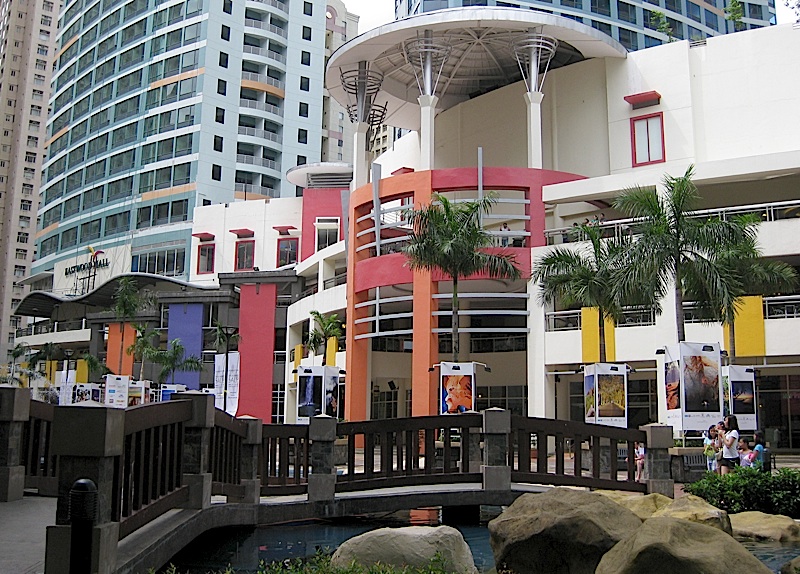

August 28, 2009
Across two cities
Looking north from the fifth floor of Fully Booked in Bonifacio High Street in Taguig City, I saw this cloud touched by the late afternoon sun rising high over the tallest buildings of the Ortigas Center in Pasig City.
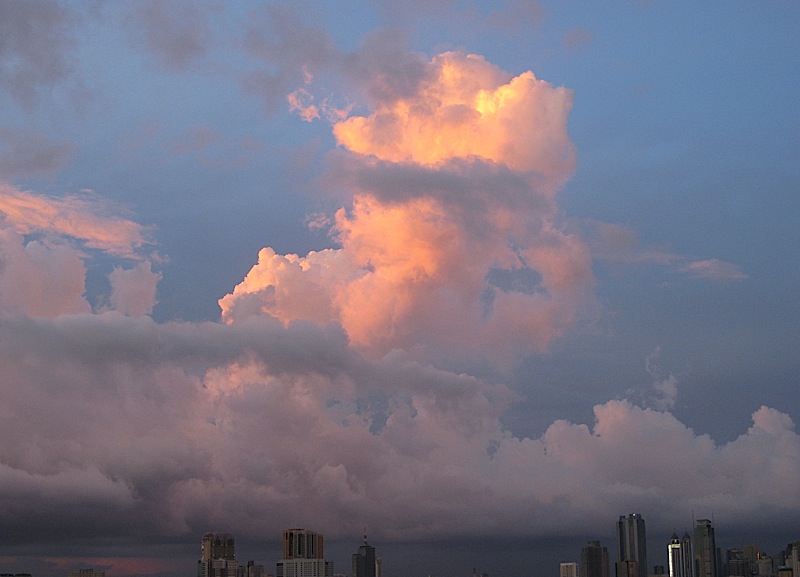


Visit the Sky Watch Friday home page and tour the skies of our beautiful world.

August 27, 2009
Twenty-four hours
Ministop is a 24-hour convenience store franchise from Japan brought into the Philippines in 2000 by the Robinsons Group. It is the direct competitor of the older 7-Eleven chain, which opened its first store in the Philippines in 1984. I don't know which of the two has more branches in the country or even in the metro, but I see more Ministop branches in the places which I pass through everyday.
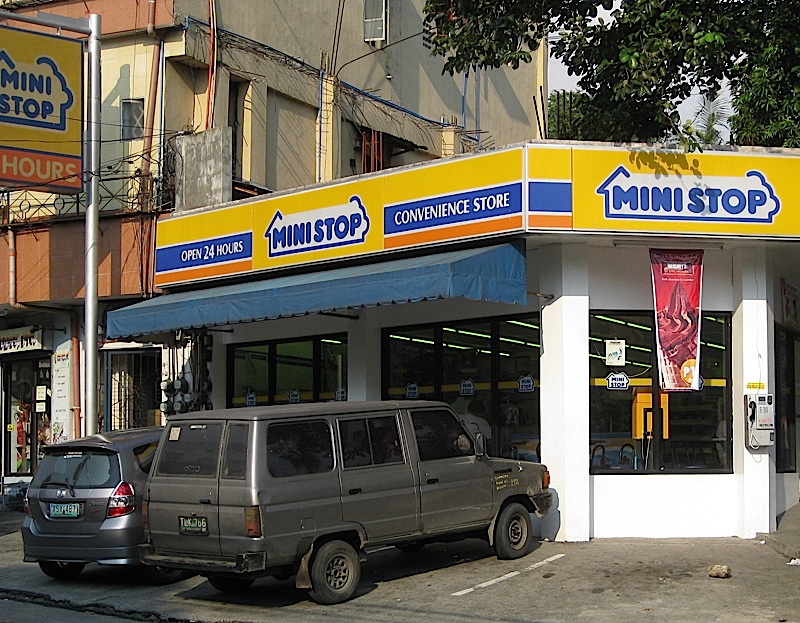

August 26, 2009
Leaping for joy
Trinoma mall in Quezon City is designed in such a way that many of the restaurants and cafés are centered around open areas which extend from the second to the fifth levels. Those open areas are filled with plants and interconnected water features. I've already posted a photo of the charming location of the Starbucks on the fifth level and another of this same area but looking up from the third floor. The jets of water are shooting up from fountains on the lower levels.
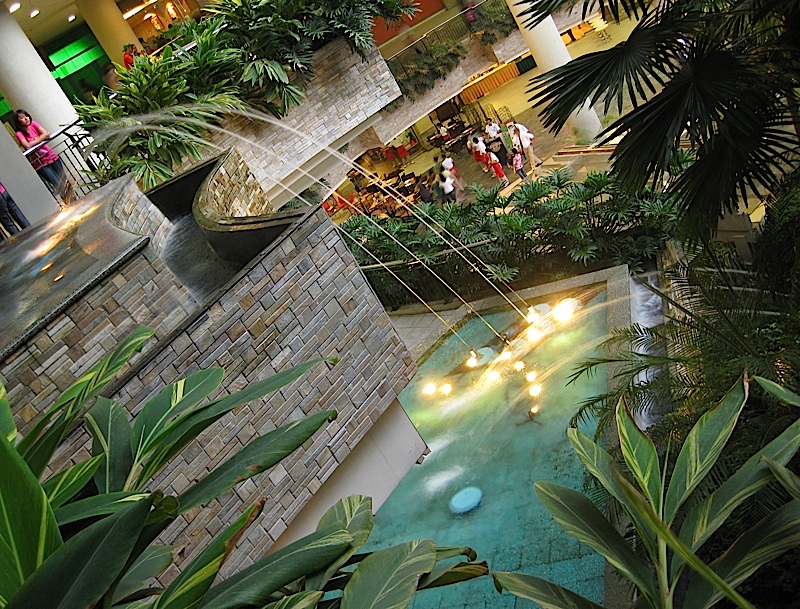


Natural or man-made, take a refreshing dip in Watery Wednesday.

August 25, 2009
Additional defense
One side of the outer wall of the Spanish colonial era Fort Santiago in Intramuros overlooks the Pasig River. Just outside the high walls is a lower wall for additional defense called a falsabraga. There are two of these overlooking the river and this one, which is at the very tip of the fort, is called the Falsabraga de Santa Barbara. I can almost imagine a guardia civil standing watch in that tiny guardhouse.
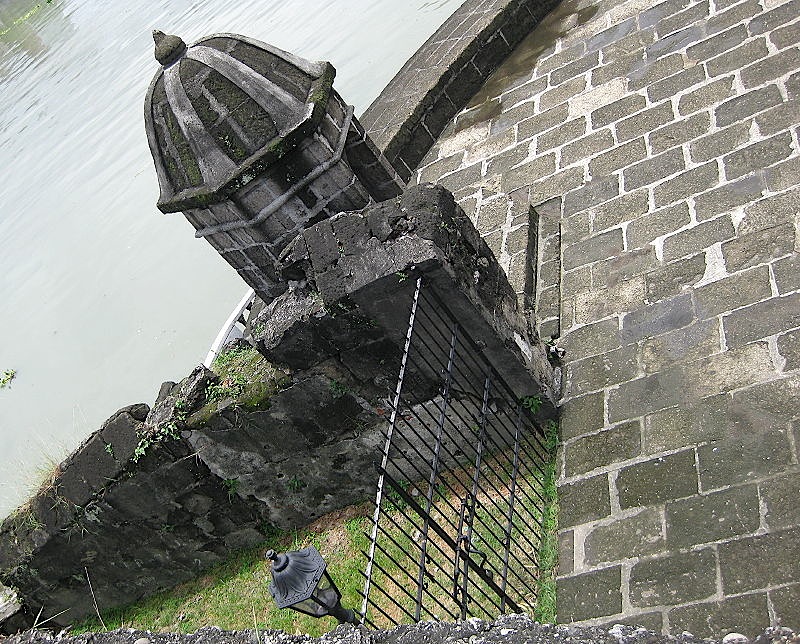

August 24, 2009
Lazy Sunday afternoon
After a heavy, delicious meal, what better way to spend a lazy Sunday afternoon than playing board and card games with family and friends? Aside from taking a nap, that is. The past five years have seen a resurgence of the popularity of tabletop games in Manila, thanks to European designer games. The games are not inexpensive, however, so it didn't surprise me when I once saw a board game café somewhere. Though I'm not against computer or video games, there is much to be said for games where you face other people rather than a video screen. This particular game is Bamboleo, a balance game that can tax your dexterity. Can you guess the goal of the game?
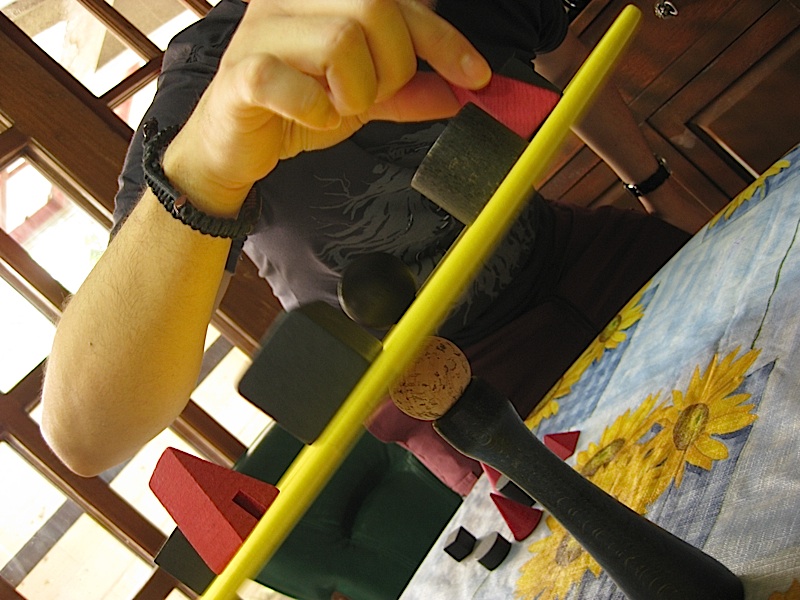

August 23, 2009
Sunday lunch
It was my husband's birthday last Sunday and we decided to try the new Filipino restaurant of chef Florabel Co at Eastwood City. Crisostomo, which boasts of "turn of the century Filipino cuisine," is named after the main protagonist of Philippine national hero Jose Rizal's "Noli Me Tangere." All of its dishes are named after other characters in the book and even the servers and busboys wear name tags of characters in the book, not their own names. One thing you have to remember about Filipino meals, whether it's Filipino cuisine or not: food is meant to be shared. In Crisostomo, the dishes are served 'family style,' which means that they are placed in the middle of the table and each person is expected to serve himself. Actually, even in non-family style restaurants where your entire meal is on one plate, it is not unusual for Filipinos to dip into each others' plates. Anyway, enough about Filipino eating customs—let's eat!
The appetizer: Ostra Maestra, Elias' Choice – oysters with garlic and cheese. There were two other choices available for the oysters, one of which was raw. In fact, I suspect that Elias' Choice was not baked either but that melted cheese was spooned over raw oysters. Very fresh.
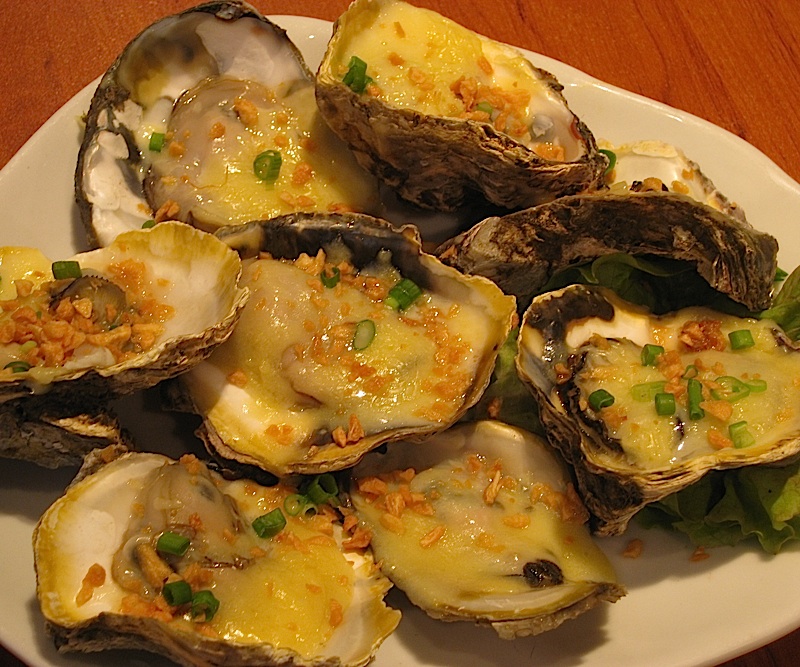
The drink: fresh buko juice. With the coconut meat sliced and served in the glass too. Of course, you'll have to use a fork to eat the slices. I think that coconut juice (some call it coconut water) is pretty good for cleansing the palate between dishes with strong flavors. Filipinos will also tell you that buko juice is very good for the digestive system, but I have no idea how true that is since I have never read a medical report about it.
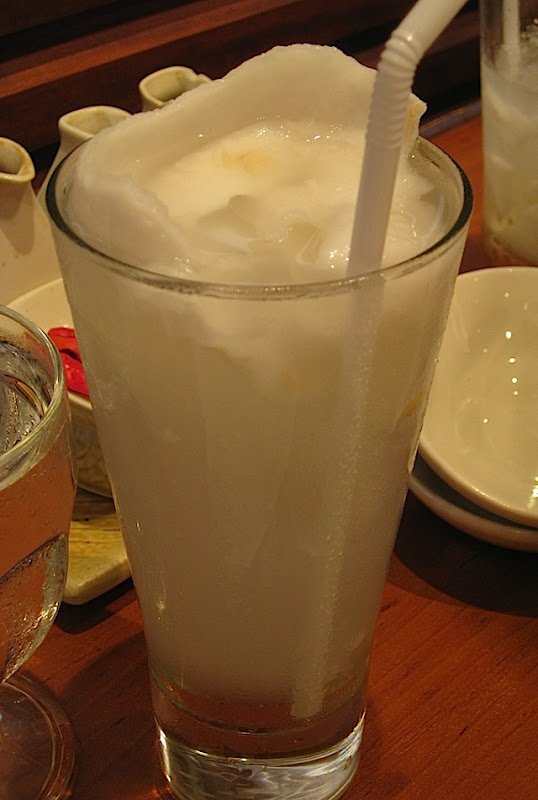
The rice: fried garlic rice. No Filipino meal is complete without rice. Crisostomo has different kinds available and if you order the basic steamed rice, you can have as much of it as you want.
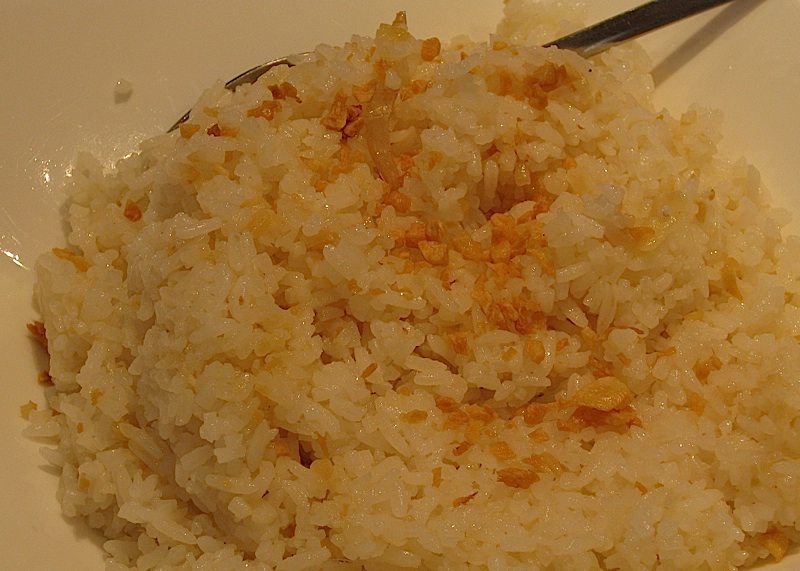
The vegetable dish: Noli Me Talong – tortang talong (eggplant omelet) with kesong puti (white cheese). Kesong puti is a local Filipino cheese traditionally made out of carabao's milk. The carabao (Bubalus bubalis carabanesis) is a type of water buffalo important to Filipino farmers as a plow animal and as a means of transportation.
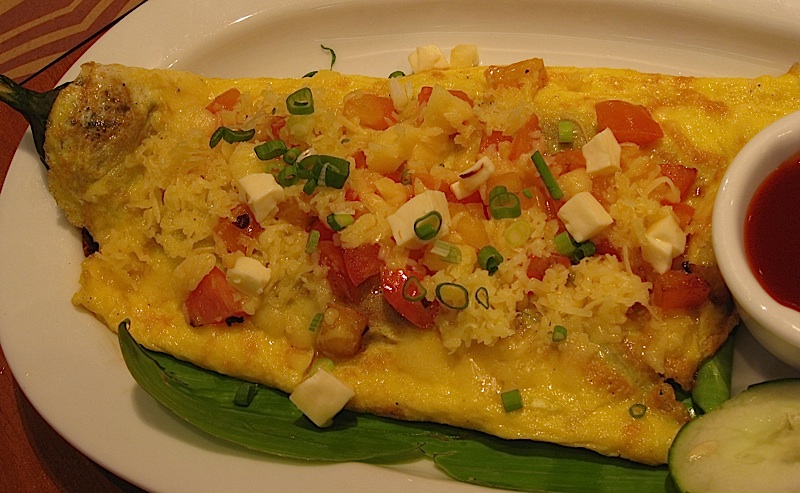
The fish: Bella Bandida – panfried bangus (milkfish) belly with burong mangga (pickled green mango). The green mango was mixed with a little bagoong (shrimp paste) too.
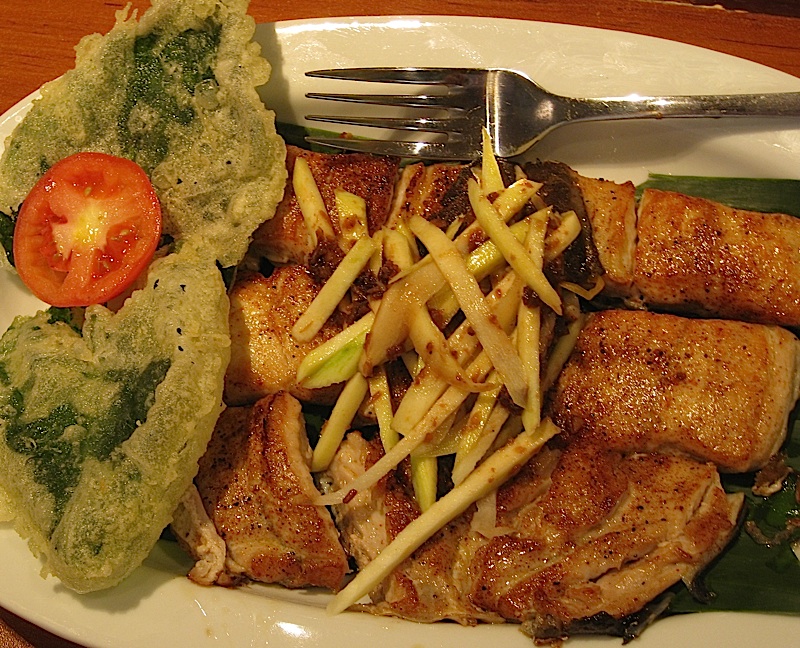
The prawns: Doña Victorina – prawns in aligue (crab fat) and gata (coconut milk). Cholesterol heaven. And yes, the prawns are served whole. I don't think I've seen a restaurant here serve prawns that have been shelled or deveined. It's just not done. The butterfly cut is acceptable though. Of course, it takes some practice to learn how to remove the shell with a knife and fork.
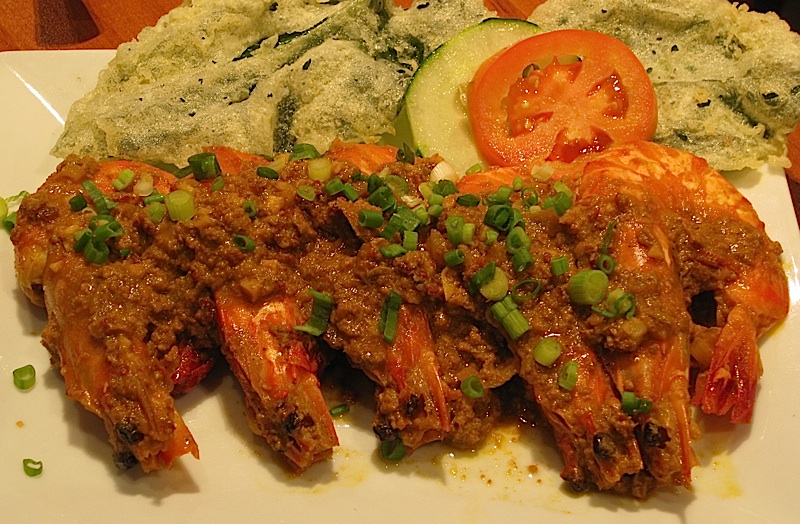
The dessert: Kapitana Maria – frozen Brazo de Mercedes. The traditional Spanish-Filipino Brazo de Mercedes is a log-shaped pastry of meringue (egg whites and sugar) with a cream filling made out of egg yolks, sugar and milk. Admittedly, Brazo de Mercedes is not a very flattering name for a pastry—it means Mercedes' arm. Use your imagination. Kapitana Maria has a cookie crust, is frozen and drizzled with caramel sauce. I think it's better than regular Brazo de Mercedes.
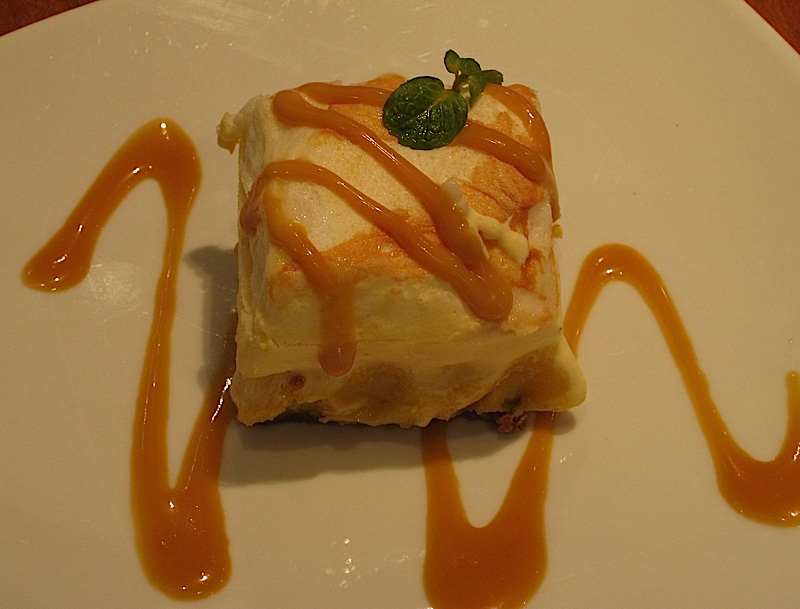
The appetizer: Ostra Maestra, Elias' Choice – oysters with garlic and cheese. There were two other choices available for the oysters, one of which was raw. In fact, I suspect that Elias' Choice was not baked either but that melted cheese was spooned over raw oysters. Very fresh.

The drink: fresh buko juice. With the coconut meat sliced and served in the glass too. Of course, you'll have to use a fork to eat the slices. I think that coconut juice (some call it coconut water) is pretty good for cleansing the palate between dishes with strong flavors. Filipinos will also tell you that buko juice is very good for the digestive system, but I have no idea how true that is since I have never read a medical report about it.

The rice: fried garlic rice. No Filipino meal is complete without rice. Crisostomo has different kinds available and if you order the basic steamed rice, you can have as much of it as you want.

The vegetable dish: Noli Me Talong – tortang talong (eggplant omelet) with kesong puti (white cheese). Kesong puti is a local Filipino cheese traditionally made out of carabao's milk. The carabao (Bubalus bubalis carabanesis) is a type of water buffalo important to Filipino farmers as a plow animal and as a means of transportation.

The fish: Bella Bandida – panfried bangus (milkfish) belly with burong mangga (pickled green mango). The green mango was mixed with a little bagoong (shrimp paste) too.

The prawns: Doña Victorina – prawns in aligue (crab fat) and gata (coconut milk). Cholesterol heaven. And yes, the prawns are served whole. I don't think I've seen a restaurant here serve prawns that have been shelled or deveined. It's just not done. The butterfly cut is acceptable though. Of course, it takes some practice to learn how to remove the shell with a knife and fork.

The dessert: Kapitana Maria – frozen Brazo de Mercedes. The traditional Spanish-Filipino Brazo de Mercedes is a log-shaped pastry of meringue (egg whites and sugar) with a cream filling made out of egg yolks, sugar and milk. Admittedly, Brazo de Mercedes is not a very flattering name for a pastry—it means Mercedes' arm. Use your imagination. Kapitana Maria has a cookie crust, is frozen and drizzled with caramel sauce. I think it's better than regular Brazo de Mercedes.

August 22, 2009
Heaven
Fully Booked in Bonifacio High Street in Taguig City has five floors of books, from the basement (science fiction, fantasy and graphic novels) to the fourth floor (music CDs and audio books of different genres). Starbucks has a coffee shop on the third floor, where the lower balcony with umbrellas is. The top floor, which also has a balcony but with plants, is a large events space perfect for book launches, writing workshops and poetry readings. Bring your own caterer.
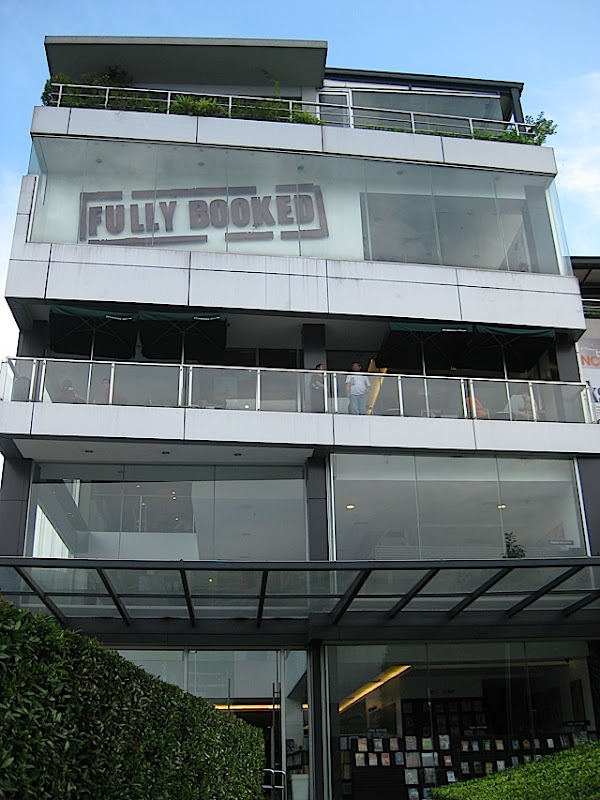

August 21, 2009
Solid
Side and front views of the massive Renaissance Towers condominium complex in Pasig City. I've never been inside, and I doubt if I ever will, but I hear that it's very luxurious and that security is very tight. I just wish there was some way to take photos of it up close without those equally solid-looking utility cables.

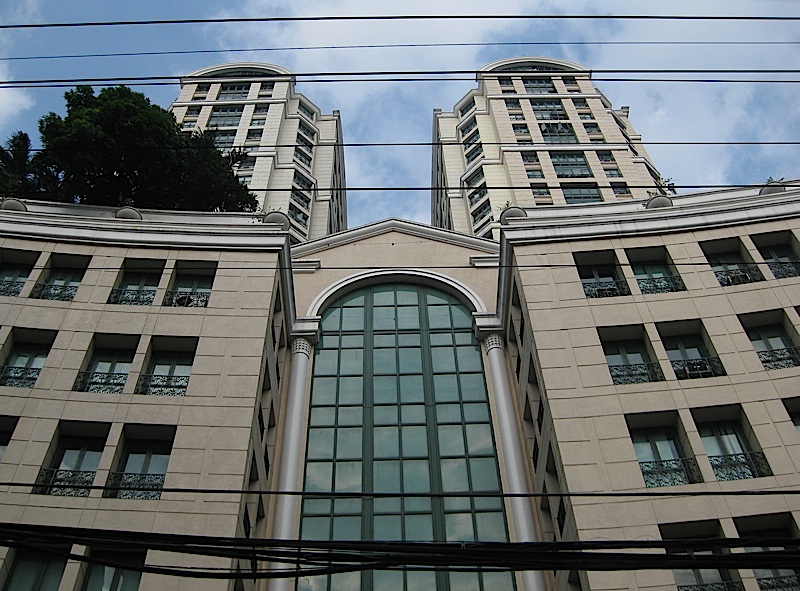


August 20, 2009
Neo-classical details
Some column and roof details of the Manila Central Post Office building designed in 1926 by Juan Marcos de Guzman Arellano.
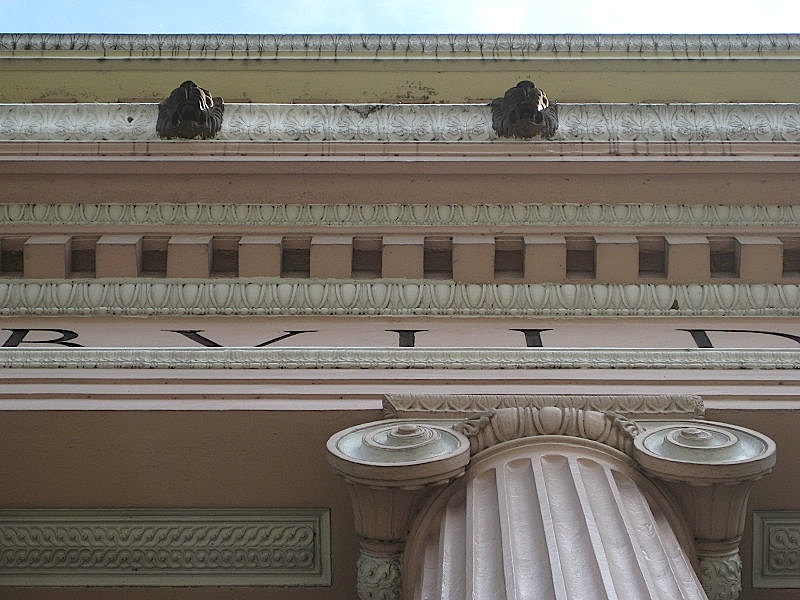
Attention all City Daily Photo bloggers! The theme for September 1 is Big and we have less than two weeks to prepare a photo. It won by a very small margin so please vote for the October theme and let's see if we can get a very clear winner this time. Don't forget to choose two before clicking on the "Submit vote" button.

Attention all City Daily Photo bloggers! The theme for September 1 is Big and we have less than two weeks to prepare a photo. It won by a very small margin so please vote for the October theme and let's see if we can get a very clear winner this time. Don't forget to choose two before clicking on the "Submit vote" button.
August 19, 2009
19th century promenade
One of the fountains in Plaza Moriones, a park just outside the main gate and moat of Fort Santiago, one of the oldest fortifications in the City of Manila. During the 19th century, it was a promenade for the residents of Intramuros. Now, the gardens can be rented for special events such as wedding receptions.



Natural or man-made, take a refreshing dip in Watery Wednesday.

August 18, 2009
The Next Wave
It is only the sixth year of the Ateneo Art Awards and it is quickly growing into a much-coveted award by Filipino artists 35-years-old and younger. From granting just one art residency in Australia, it now grants four with the addition of programs in Indonesia, Singapore and New York. The exhibit and awarding ceremony venues are always high-profile, which is one reason why it has been very successful. The first four years, it was at the Power Plant Mall in Makati City. In 2008 and this year, it was at the Shangri-la Plaza Mall in Mandaluyong City. I finally decided to satisfy my curiosity and attended last week's ceremony for the 2009 awards. I took this from a higher floor quite early when people were just starting to arrive for the cocktails. Two hours later, the cordoned-off area was jam-packed with artists and society people and one could hardly move around, much less appreciate the artwork. When the exhibit moves to the more peaceful Ateneo Art Gallery, I'll try to visit and take pictures of the winning pieces, but in the meantime, photos of the twelve in the short list are here.
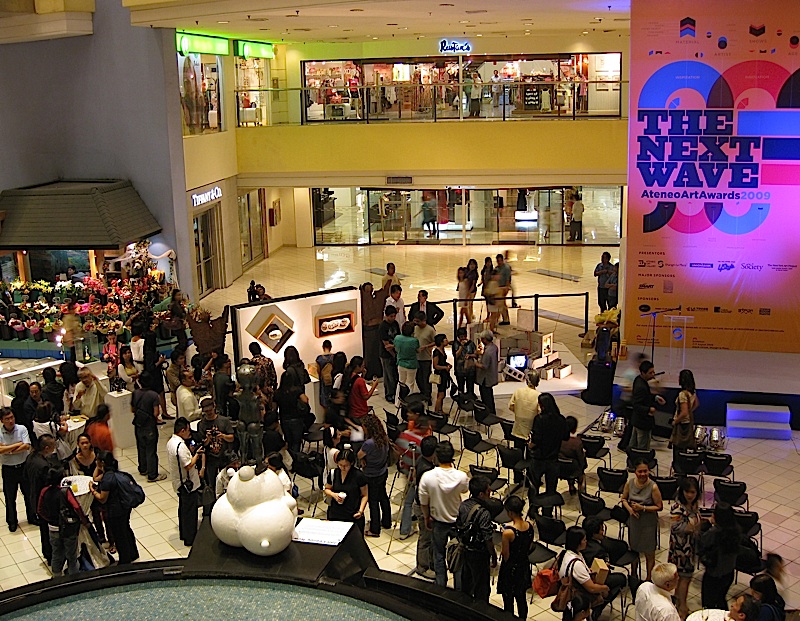

Posted by
Hilda
14 comments:
August 17, 2009
Shared habitat
The Penguin Café Gallery in Malate, Manila (just several blocks away from the Malate Church) derived its name from the owner's large collection of penguins. Here is one decorating a lamp in a corner, with a couple of penguins painted on the window. I don't know if geckos have the same type of habitat, but this twisted one looks happy enough sharing the same space as the penguins.
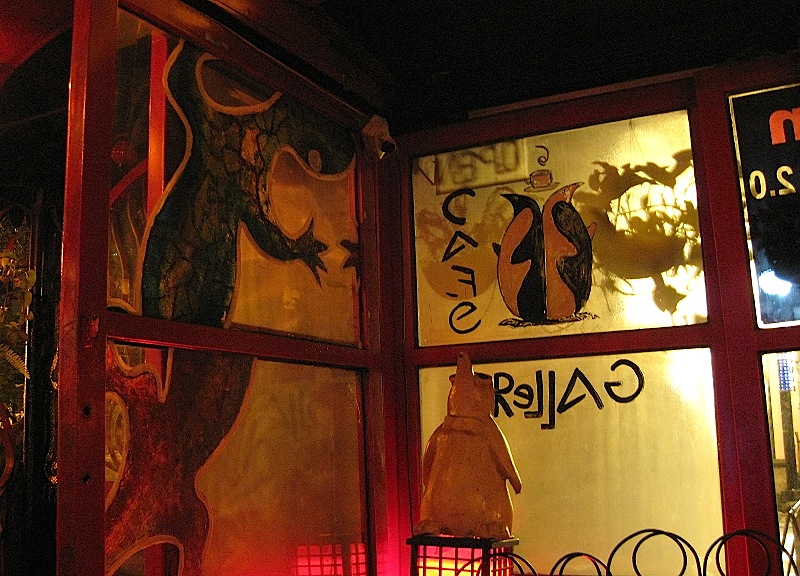


Find more Odd Shots—or post your own—at Katney's Kaboodle.

August 16, 2009
Gray and gold
Because I do not have photos of the San Agustin Church's interior yet, on this Sunday, I offer you instead a view of the Manila Cathedral's nave and sanctuary. Someone once mentioned to me that he didn't like the Manila Cathedral's ceiling because it was so simple. Yes, none of the domes have paintings but I like the sculpted details of the arches, pillars and clerestory, and how the cold grays contrast yet blend with the warm browns and golds of the pews and altar.
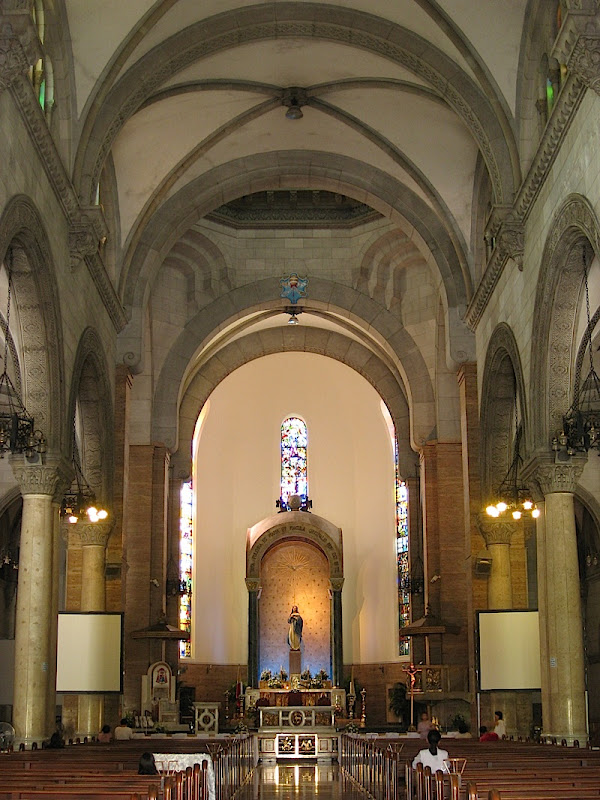

August 15, 2009
Pink salad
Pomelo (Citrus grandis or Citrus maximus) has two names in the Philippines depending on what region of the country they, or the speaker, are from. The ones from the province of Quezon in Luzon are called lukban (there is a town named Lucban there too) and its flesh is usually yellow. The ones from the Davao region in Mindanao are called suha and are pink. The pink variety is sweeter and more easily available in Manila so the name suha is also more commonly used. Americans usually observe that the pomelo looks like a grapefruit. Never having seen or tasted grapefruit myself, I can't compare the two, but friends who have tasted both say that the pomelo is sweeter. During the past decade or two, pomelo started appearing as a salad ingredient in restaurants here, and I will forever be grateful to the person who started it because it's very refreshing. The pomelo and shrimp salad of the Vietnamese restaurant Zao is unusual in that it has more pomelo than lettuce but it was also very good.
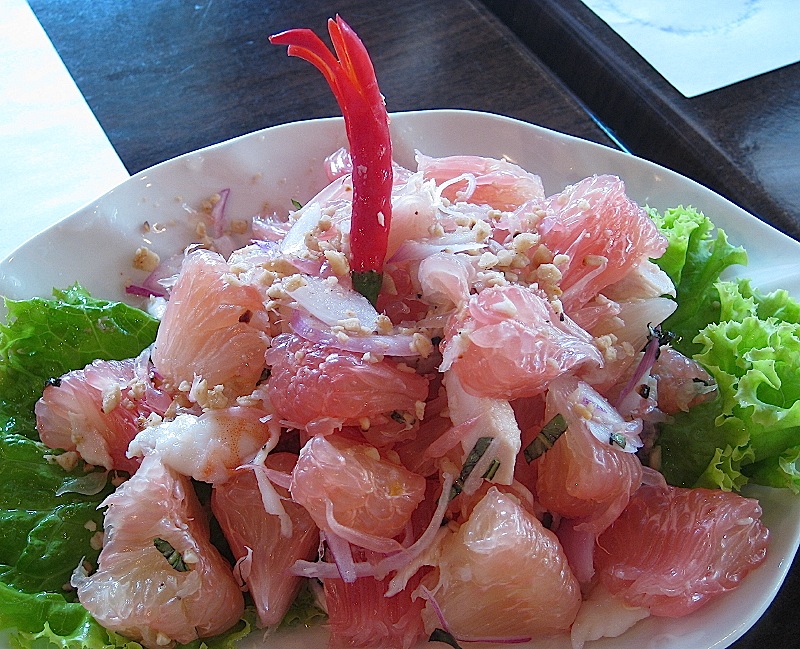

August 14, 2009
Baroque melon
Storm clouds forming over the San Agustin Church in Intramuros, one of the four Baroque Churches of the Philippines listed as a UNESCO World Heritage Site. The first Agustinian church on this site was made of bamboo and nipa and built in 1571. The current church, the third, was built from 1586 to 1607 and designed by the Spanish soldier-architect Juan Macias. The building on the right, which used to be the site of the monastery which was completely destroyed during WWII, is the church museum built in the 1970s. A wedding was about to begin on the day we visited and we couldn't go inside the church. I will have to do so some other time to take photos of its amazing trompe l'oeil ceiling and walls.
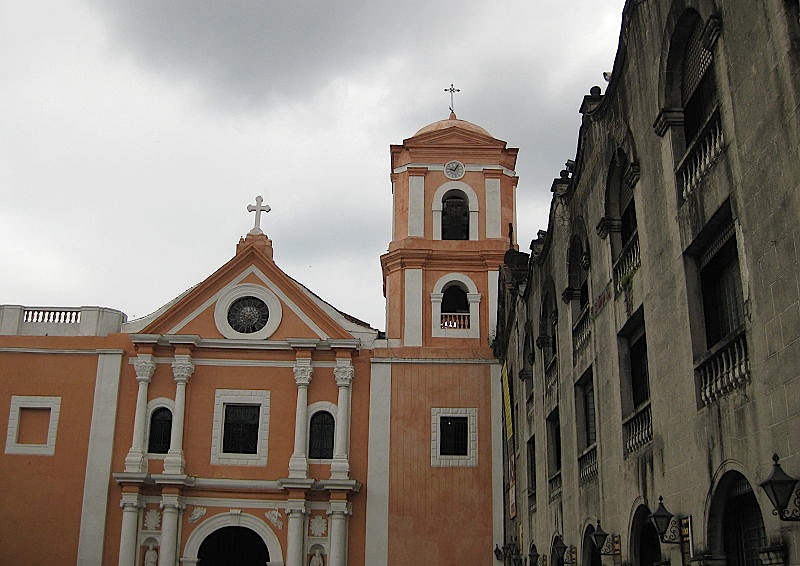


Visit the Sky Watch Friday home page and tour the skies of our beautiful world.

August 13, 2009
Ongaku in Motion
One of the perks of working at a university is the wide range of learning opportunities right at our doorstep. And no, they are not all dry lectures. Last month, the Ateneo de Manila's Japanese Studies Program, with the assistance of the Japan Information and Cultural Center of the Embassy of Japan, celebrated the Philippines-Japan Friendship Month with "Ongaku in Motion." Ongaku means music in Japanese. The first half of the program featured traditional Japanese music and dance. This is a koto, which is the national instrument of Japan.
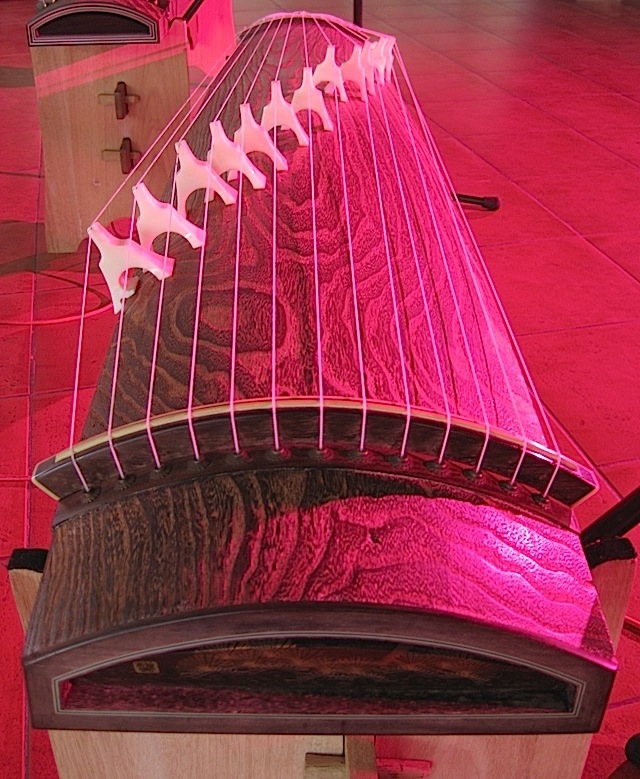
After several pieces of koto music, played by the Director of the Japanese Studies Program and a member of the University of the Philippines Koto Ensemble, one faculty member performed a Nihon Buyo dance. It was fascinating with its slow, exact and refined movements.
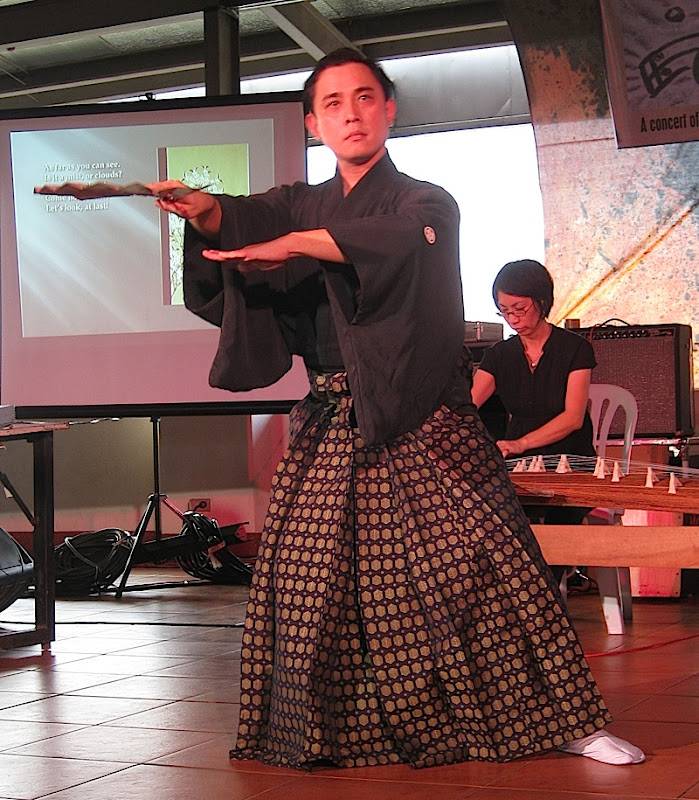
Unfortunately, I couldn't stay for the second half of the program, which featured J-pop and anime music performed by the students.

After several pieces of koto music, played by the Director of the Japanese Studies Program and a member of the University of the Philippines Koto Ensemble, one faculty member performed a Nihon Buyo dance. It was fascinating with its slow, exact and refined movements.

Unfortunately, I couldn't stay for the second half of the program, which featured J-pop and anime music performed by the students.
August 12, 2009
The eye of the storm
In the center of all the Greenbelt malls is the park that gives the area its name. Within the park, surrounded by hundreds of shops and restaurants, is the little Greenbelt Chapel. It was built in 1983 and many of its design elements were created by noted glass sculptor Ramon Orlina. I hope I can visit it soon to take photos, but for now, we have to end our short Ayala Commercial Center walk. And I leave you with an image that is very representative of today's Manileño—a religious center amidst all the commercialism and consumerism of the city. I find it both ironic and hopeful.
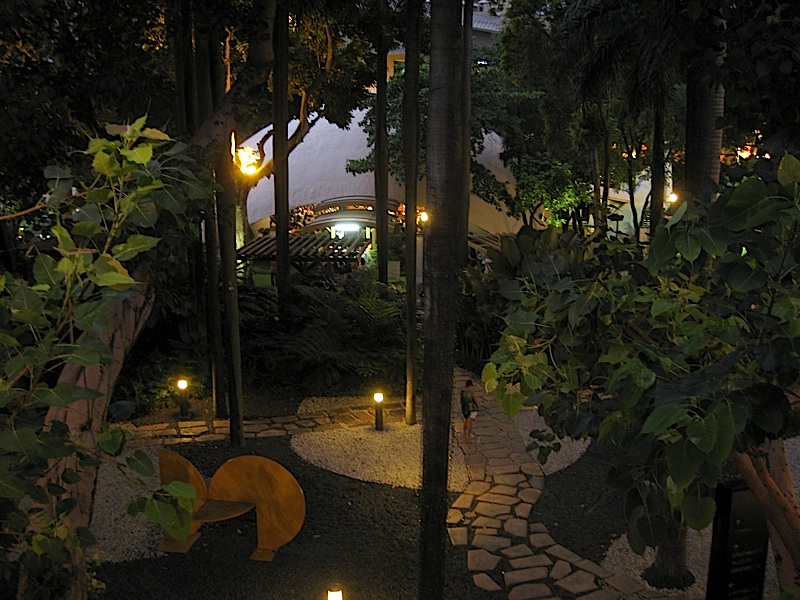

August 11, 2009
It's in the details
From the glass and concrete of the Glorietta area, we are now on the footbridge crossing Makati Avenue into the warmth and lushness of Greenbelt, still a part of the Ayala Commercial Center. This is the driveway and bridge between Greenbelt 4 (the building on the right) and Greenbelt 3 (off the picture to the left). I already posted photos of Greenbelt 2 and Greenbelt 5 in the past. Don't you just love that bridge and stairwell?


August 10, 2009
Roundabout park
A rotonda (roundabout) within the Ayala Commercial Center gives vehicles access to The Link, Makati Shangri-La, 6750 and Glorietta (a different entrance from the one in my photo though). Not one to waste even the smallest piece of real estate, Ayala Land turned the little lot inside the rotonda into a tiny park with landscaped gardens. The tent would make it a perfect venue for the center's events too.
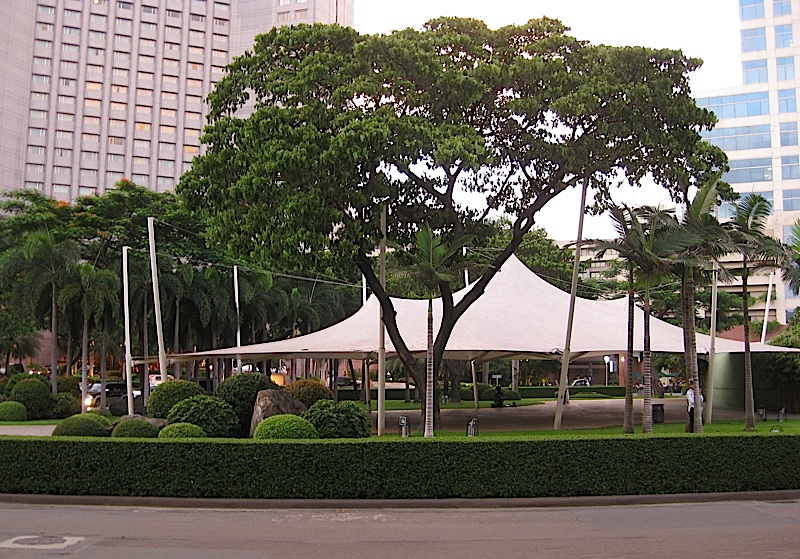

August 9, 2009
Legoland
Since I always take the cooler route through Glorietta whenever I walk from the Ayala Station to Greenbelt, this was the first time I saw this building: The Link at the Ayala Commerical Center. The last time I was out here, the lot that it's standing on was still part of the open car park beside the Makati Shangri-La. I have no idea when The Link was built or what is in it other than the restaurants and service shops which can be seen on the two lower levels. I like how it looks though, like it was built out of Lego® bricks!
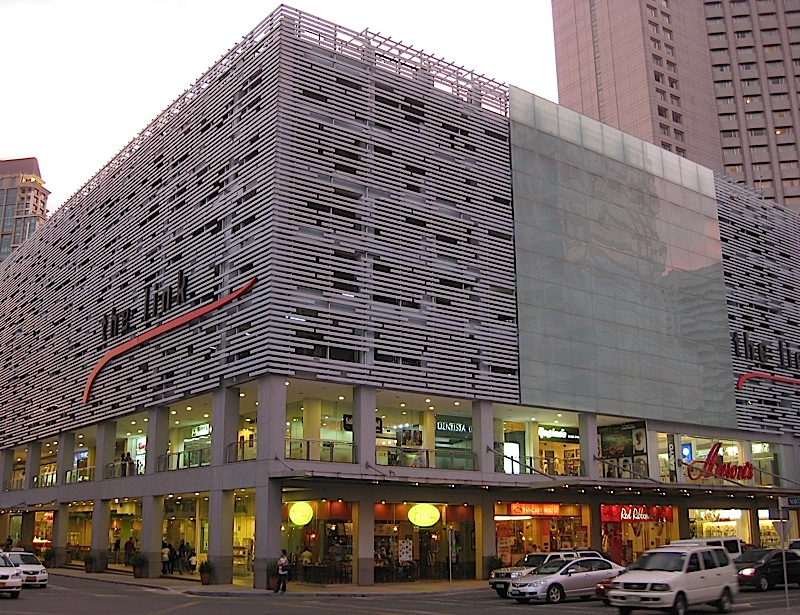

August 8, 2009
Urban paradise
Shangri-La has three hotels in Metro Manila. We've already taken a peek at the roofdeck tennis courts of the Edsa Shangri-La back in February. To the left of yesterday's 6750 is the Makati Shangri-La at the Ayala Commercial Center. It stands at the corner of Ayala and Makati Avenues but its main entrance, unfortunately hidden by all the trees here, can only be accessed from within the commercial center. Like the InterCon earlier this week, the exterior doesn't look like much, but everything inside is very luxurious and the Makati Shangri-La is the best of the three in the metro.
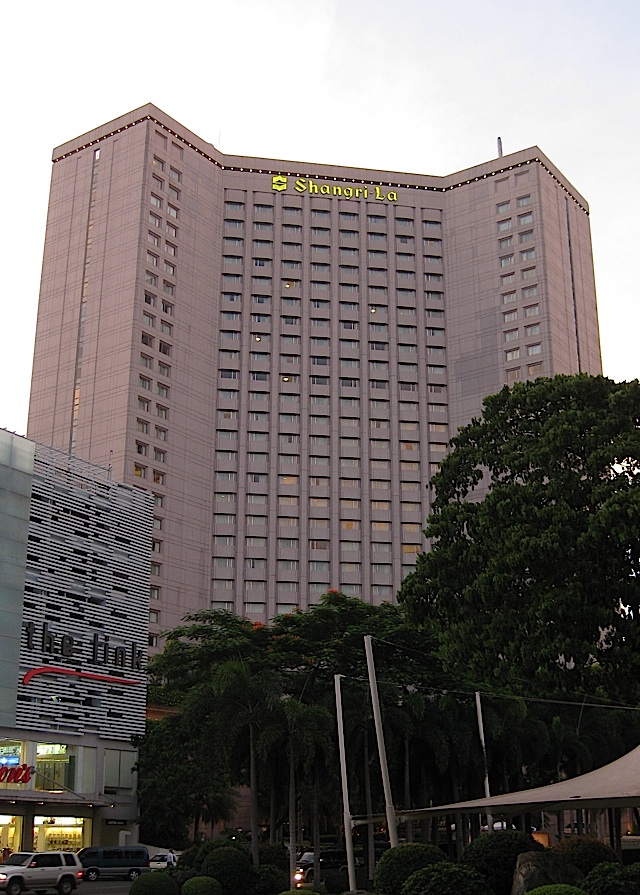

August 7, 2009
6750
When it opened in 1992, 6750 Ayala Avenue became one of the most prestigious business addresses in Makati City. It is the only office tower in the Ayala Commercial Center and continues to house the offices of Procter and Gamble Philippines, Caltex Philippines and other multinational corporations. The ground level has a few retail spaces, currently occupied by luxury brands Bulgari, Escada and Louis Vuitton. Of course, it also has the ubiquitous Starbucks.
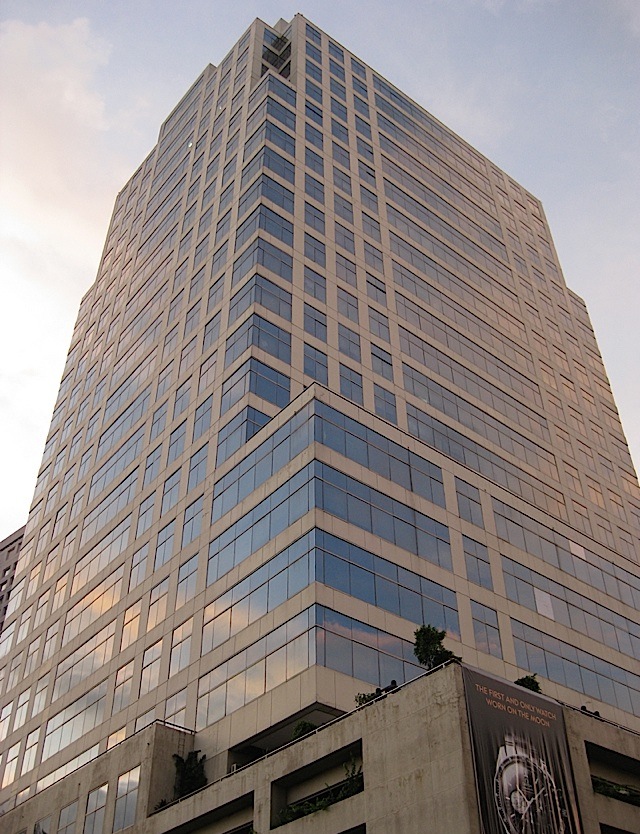


Visit the Sky Watch Friday home page and tour the skies of our beautiful world.

August 6, 2009
Soldiers with a taste for luxury
Across yesterday's Glorietta 5 is one of the entrances to the sprawling, original Glorietta which is actually several interconnected malls. 1 to 4 should be in there somewhere. When I was much younger, these shopping centers were all separate buildings until the property arm of the Ayala Corporation, which owns all the land in the Ayala Commercial Center, decided to put them all literally under one roof. It has a big, circular area in the middle for mall events, with a stage for performances and a playground for children. When walking from the Ayala Station to Greenbelt, I usually cut across inside because of the airconditioning. The two tall towers connected to the mall are the Ascott Makati with its luxurious serviced residences, a cross between a hotel and an apartment. It used to be called the Oakwood Premier and this was where a group of more than 300 soldiers decided to hole up when they mutineed against President Gloria Macapagal Arroyo in 2003. It was soon after the Oakwood Mutiny that Ayala Land turned over management of the serviced residences to the Ascott Group.


August 5, 2009
Another 5th
Right in front of yesterday's InterCon stands the newest mall in the Ayala Commercial Center: Glorietta 5. It's so new, not all the shops and restaurants are open yet. It's not just a mall though since it also has office spaces—probably the five floors above the balconied levels. I like the building's stark, very graphic design.
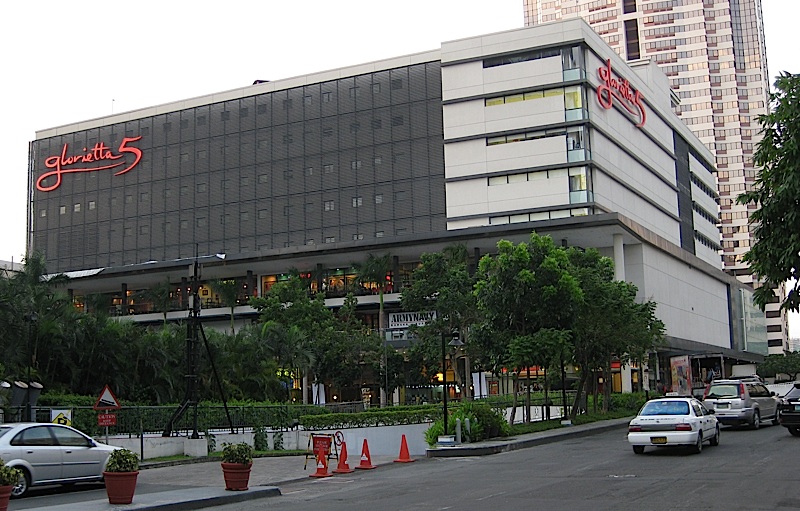

August 4, 2009
No. 1 Ayala Avenue
Just a block away from yesterday's Ayala Station is the InterContinental Manila, more popularly known here as the InterCon. It is one of several hotels in the Ayala Commercial Center. The hotel was designed in 1969 by Philippine National Artist for Architecture Leandro Locsin (1928–1994). Despite its age, or maybe because of it, the InterCon is still considered one of the best hotels in Metro Manila. Its Suriya Spa and Prince Albert Rotisserie, a French fine dining restaurant which has won numerous awards, are well-known and some of my friends swear that the cheesecake at its Jeepney Deli Shop is the best in town.
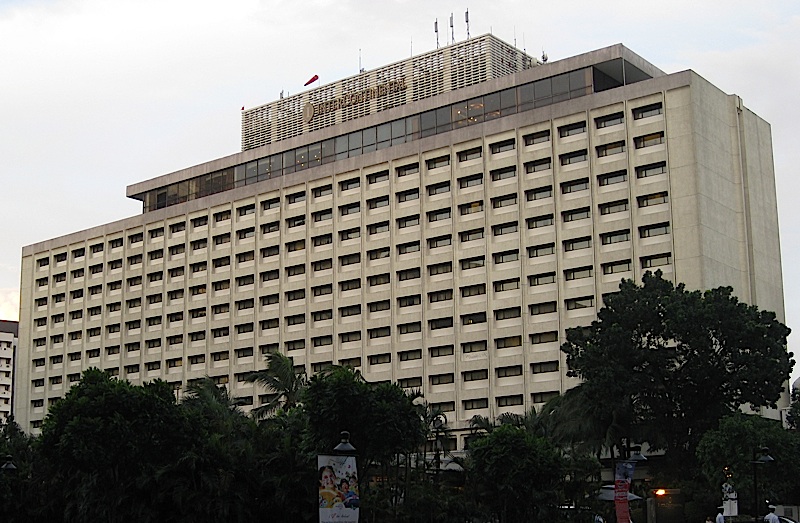

August 3, 2009
Ayala Station
The photo of Greenbelt 5 which I posted for the CDP theme day on Saturday was the last in a series of photos which I took in the Ayala Commercial Center on the evening that we watched Rep's The Fantasticks. So let's begin our tour properly at the beginning, shall we? I took the MRT from Quezon City to Makati City and this is where I got down, the Ayala Station. Buses on the ground level, trains on the upper, and lots of food stalls along the way. The cinder block of a building on the right is another mall: SM Makati.


August 2, 2009
Tie a yellow ribbon
The entire Philippines mourns the passing of former president Corazon C. Aquino, the widow, housewife and mother who became our focal point for democracy during the last few years of the Marcos dictatorship. She was installed as our 11th president during the 1986 People Power Revolution, and became the Philippines' and Asia's first female president. Yellow was her color back then and when news came out last week that she was seriously losing her battle with cancer, people again started tying yellow ribbons everywhere—on trees, gates, fences, cars—even pinning yellow ribbons on our shirts. This particular tree is in front of the Ateneo Church of the Gesù, whose glass cupola can be seen in the background. Mrs. Aquino may not have been the perfect president, but no one could doubt her moral uprightness, both during and after her term in office. Farewell, tita Cory. We are going to miss your clear voice, especially as we near the 2010 elections.
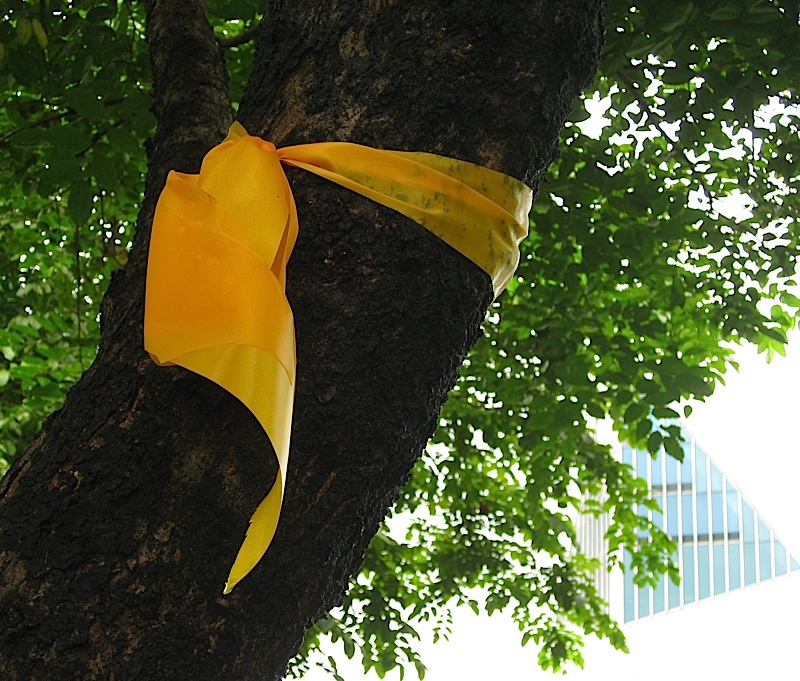

August 1, 2009
Posh mall
THEME DAY: NIGHT • Considering the fact that Metro Manila has a large number of malls, I guess it was inevitable that I would show one for a City Daily Photo theme day. Greenbelt 5 is located at the Ayala Commercial Center in Makati City. I haven't explored it yet but I hear that most of its shops are those of international luxury brands and top Filipino artists and designers. Much too upscale for me. But I also hear that many of its restaurants are fantastic so we just might go there one of these days anyway.
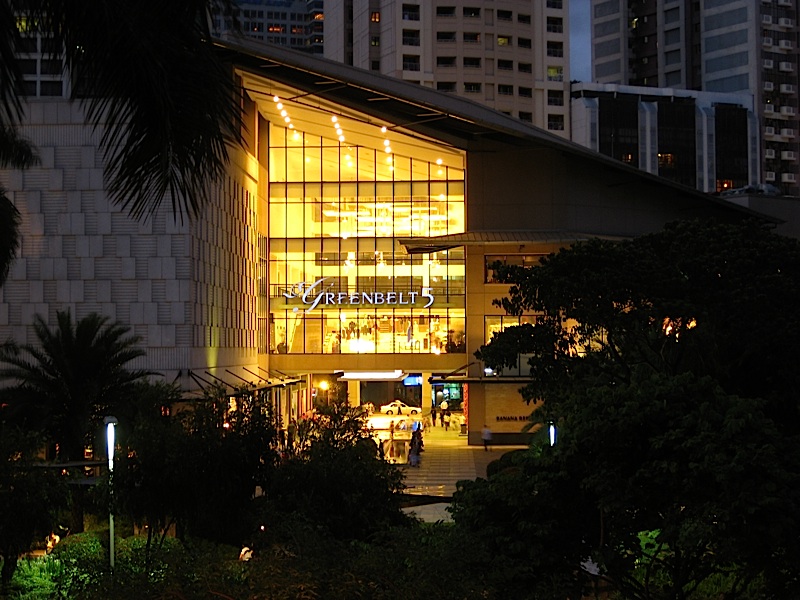
I think it's more correct to describe this as an evening shot since the sky is still light even though the sun had set. But evening or night, I think we're going to see a lot of great photos from City Daily Photo bloggers around the world. Click here to view thumbnails for all participants.

I think it's more correct to describe this as an evening shot since the sky is still light even though the sun had set. But evening or night, I think we're going to see a lot of great photos from City Daily Photo bloggers around the world. Click here to view thumbnails for all participants.
Subscribe to:
Posts (Atom)